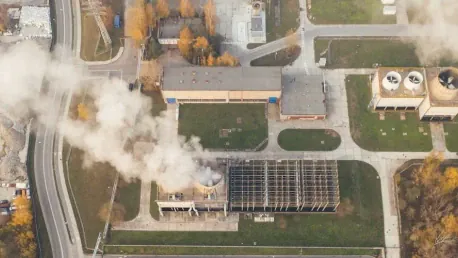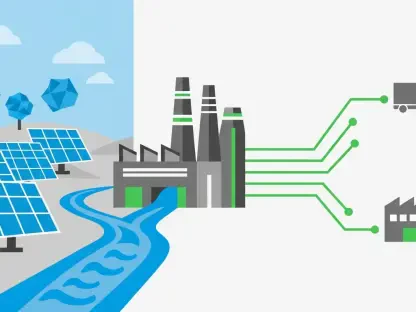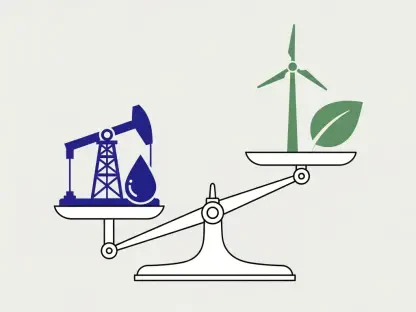Smart buildings are at the forefront of the drive towards energy efficiency and sustainability, and Infineon’s XENSIV™ PAS CO2 5V sensor is a groundbreaking innovation that significantly enhances the efficiency of smart buildings. This article delves into the various ways this advanced sensor technology contributes to optimizing energy consumption, reducing carbon emissions, and improving indoor air quality. By integrating a multitude of modern solutions, Infineon aims to create a sustainable future where smart buildings will play a pivotal role in environmental conservation.
Infineon’s initiative to enhance energy efficiency in smart buildings through the introduction of the XENSIV™ PAS CO2 5V sensor exemplifies how advanced technology can contribute to reducing global carbon emissions. This extensive analysis dives into how this innovative solution aligns with broader trends in sustainability, technological advancement, and smart building management. Understanding its applications and impact provides valuable insights into the future of building automation and the pivotal role such technology will play.
The Role of Buildings in Global Energy Consumption
Buildings are integral to global energy consumption and substantially impact carbon emissions, accounting for 40% of emissions worldwide due to energy used for heating, ventilation, and air conditioning (HVAC). Optimizing building efficiency is essential to climate mitigation, which Infineon addresses through its new XENSIV™ PAS CO2 5V sensor. This sensor significantly contributes to optimizing HVAC energy consumption, consequently supporting efforts to combat climate change while maintaining key indoor environmental standards.
The substantial role that buildings play in global energy consumption stems from their dependence on energy-intensive systems like HVAC. These systems are necessary for maintaining comfortable living and working conditions but tend to consume enormous amounts of energy. By introducing smart technologies that monitor and regulate energy use more efficiently, such as the XENSIV™ PAS CO2 5V sensor, Infineon addresses a critical component of global climate strategies. As regulatory standards become increasingly stringent, and as public awareness of environmental issues grows, such technological advancements are likely to become more central in efforts to reduce our collective carbon footprint.
Enhancing HVAC Systems with Demand-Controlled Ventilation
The XENSIV™ PAS CO2 5V sensor enhances HVAC systems through demand-controlled ventilation (DCV) by constantly monitoring indoor air quality. This continuous monitoring adjusts ventilation rates based on real-time data, optimizing energy efficiency and reducing carbon footprints. By ensuring accurate CO2 levels and maintaining a comfortable indoor environment, the sensor supports occupant well-being and productivity.
Implementing demand-controlled ventilation with this sensor ensures that energy consumption is closely aligned with the actual needs of the building, avoiding the wastefulness associated with traditional fixed-rate ventilation systems. Continuous and precise monitoring means that the right amount of ventilation is provided exactly when needed, which is especially useful in commercial and residential buildings where occupant density and activity levels fluctuate. This not only reduces energy usage but also improves indoor air quality, creating healthier, more comfortable living and working environments.
Challenges in Existing Sensor Technologies
Existing sensor technologies face several challenges that impede their use in optimizing HVAC systems. Electrochemical CO2 sensors are generally low-cost but demand frequent recalibration and replacement due to their limited lifespan. They are also sensitive to temperature and humidity changes, affecting their reliability. Non-Dispersive Infrared (NDIR) sensors, while offering accuracy and a long lifespan, are bulky, expensive, and require complex recalibration and installation processes. These drawbacks limit their application scope in compact devices. eCO2 sensors, on the other hand, provide indirect CO2 measurements that are less accurate and can be prone to false readings due to sensitivity to various volatile organic compounds.
Electrochemical sensors, although cost-effective, face significant challenges in terms of maintenance and accuracy. Their need for frequent recalibration and susceptibility to environmental changes undermines their reliability, especially in dynamic conditions. NDIR sensors, despite their accuracy, encounter issues related to size, cost, and installation complexity. Their larger, more cumbersome design makes them less suitable for compact or integrated systems. Meanwhile, eCO2 sensors struggle with precision, often delivering less accurate measurements and sometimes generating false readings. These issues highlight the need for more advanced sensor technology that can provide reliable, accurate, and cost-effective CO2 monitoring.
Addressing Challenges with the XENSIV™ PAS CO2 5V Sensor
The XENSIV™ PAS CO2 5V sensor leverages Photoacoustic Spectroscopy (PAS) to overcome these limitations, offering enhanced precision, reliability, and cost-effectiveness. Its small size, combined with high-performance standards, makes it ideal for diverse applications, including HVAC, IoT, and consumer devices. With dimensions of 14 × 13.8 × 7.5 mm³, the sensor is significantly smaller and lighter than comparable NDIR sensors. This compact design facilitates integration into space-constrained environments without compromising performance.
By utilizing photoacoustic spectroscopy, the XENSIV™ PAS CO2 5V sensor provides unparalleled accuracy and stability. PAS technology enables precise CO2 measurement unaffected by the typical drawbacks of previous sensor generations. The sensor’s compact size and high-performance parameters make it an attractive choice for various applications where space and weight are critical factors. These improvements mark a significant advancement in sensor technology, addressing the shortcomings of older methods, and paving the way for more efficient and practical implementations in smart buildings and other technologies.
Technical Highlights of the XENSIV™ PAS CO2 5V Sensor
The sensor boasts an accuracy of ±50 ppm ±5% over a range of 400 to 3,000 ppm. It has a lifespan of 10 years in typical indoor environments, with a fast response time of 55 seconds, ensuring reliable performance in dynamic conditions. The XENSIV™ PAS CO2 5V sensor supports UART, I2C, and PWM interfaces for easy integration with microcontrollers and digital systems. These features make the sensor exceptionally adaptable, allowing it to be seamlessly integrated into existing networks and technologies.
The sensor’s long lifespan and rapid response time contribute to its overall efficiency and reliability, making it suitable for use in environments where consistent, accurate monitoring is critical. The variety of supported interfaces ensures that it can be easily incorporated into a wide range of systems, from stand-alone units to complex networked environments. Its robust technical specifications underscore its superiority over other CO2 sensors, highlighting the significant advancements achieved through the application of PAS technology. Such innovations mark a forward step in creating smarter, more sustainable buildings.
Aligning with Global Decarbonization Efforts
The drive for decarbonization is a global imperative, with governments, industries, and organizations striving to meet international climate targets. Buildings, given their substantial contribution to carbon emissions, are a critical focus for innovative energy management solutions. CO2 sensors like Infineon’s XENSIV™ PAS CO2 5V sensor are integral to this trend, enabling precise DCV in HVAC systems to maximize energy savings while maintaining optimal indoor air quality.
Addressing global decarbonization efforts requires innovative tools and strategies capable of making impactful contributions. The XENSIV™ PAS CO2 5V sensor by Infineon not only maximizes energy efficiency but also directly supports decarbonization by reducing HVAC-related emissions. Such technologies are essential for achieving international climate goals and ensuring a healthier, more sustainable future. With accurate CO2 measurements and real-time data integration, buildings can significantly improve their environmental footprints, aligning with global objectives for reduced carbon emissions.
Supporting the WELL™ Building Standard
Infineon’s solution aligns with the WELL™ building standard, underscoring the importance of human health and well-being in building design. By meeting performance requirements focused on air quality, the sensor supports the creation of healthier, more sustainable indoor environments. The WELL™ standard emphasizes indoor environmental quality, making it a key consideration for modern building design aimed at improving the human experience.
Incorporating Infineon’s XENSIV™ PAS CO2 5V sensor into building systems aligns with these standards, promoting both sustainability and occupant health. The sensor’s ability to accurately monitor and adjust CO2 levels ensures that buildings can meet WELL™ requirements, providing optimal indoor air quality. Adhering to such standards not only enhances occupant well-being but also adds value to the building by ensuring it meets recognized benchmarks for health and sustainability. This adherence supports broader trends in modern building practices, prioritizing human-centric design while contributing to environmental goals.
Eliminating Redundancies in Sensor Technologies
While existing sensor technologies possess merits, they are frequently plagued by issues such as high costs, bulkiness, and the need for regular recalibration. The XENSIV™ PAS CO2 5V sensor addresses these shortcomings by introducing a more compact, reliable, and cost-effective CO2 monitoring solution utilizing PAS technology. This sensor’s pivotal role in HVAC optimization and IoT applications promotes both improved energy efficiency and indoor air quality.
By overcoming the common drawbacks of traditional CO2 sensors, Infineon’s PAS sensor streamlines HVAC and other smart building applications. Its compact design, coupled with superior reliability and lower maintenance requirements, addresses the inefficiencies that commonly plagued prior technologies. This shift not only enhances overall building management but also aligns with contemporary needs for more scalable, efficient solutions. The reduction in redundancies and improvements in sensor technology signal a progressive move toward smarter, more economical building designs that prioritize both sustainability and functionality.
Versatility and Broad Application Potential
Infineon’s XENSIV™ PAS CO2 5V sensor epitomizes the intersection of advanced technology and sustainability. By leveraging PAS, this sensor provides accurate CO2 measurements crucial for optimizing HVAC operations. Its compact, integrated design simplifies deployment in diverse settings, from smart buildings to IoT devices, highlighting its versatility and broad application potential. The sensor’s adaptability to various interfaces and environmental conditions makes it a versatile tool for improving building management and automation systems.
Beyond traditional HVAC systems and building automation, the sensor demonstrates potential in innovative sectors such as smart horticulture and refrigeration. In horticulture, it can optimize plant growth conditions by ensuring accurate CO2 levels, while in smart refrigeration, it helps in detecting refrigerant leaks, ensuring food freshness and safety. This versatility underscores the wide-ranging applicability of the sensor, extending its benefits far beyond conventional uses. Its innovative design and multifaceted capabilities set new benchmarks in CO2 monitoring, redefining possibilities across various industries.
Conclusion
Recent CO2 sensor advancements, particularly through photoacoustic spectroscopy, have tremendously improved accuracy, reliability, and cost-effectiveness. Infineon’s XENSIV™ PAS CO2 5V sensor stands out with its compact size, extended lifespan, and comprehensive features. It supports the WELL™ building standard’s performance requirements, enhances building energy efficiency, and maintains indoor air quality, thereby reinforcing its pivotal role in smart building technologies. Building on this technology, Infineon also targets broader environmental sensing applications, including refrigerant leakage detection for A2L refrigerants, further expanding its environmental sensor portfolio.
The commitment to developing innovative sensor solutions has positioned Infineon as a leader in the drive towards more sustainable and efficient buildings. This underscores the critical role of advanced technology in addressing global climate challenges. Through these innovations, the potential for significant reductions in global carbon emissions becomes an increasingly achievable goal, and smarter, more efficient buildings stand at the forefront of this endeavor.









